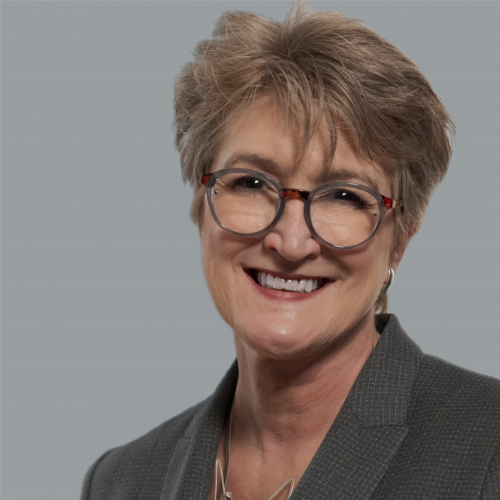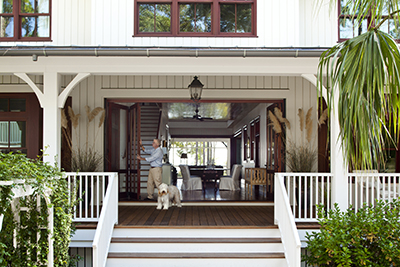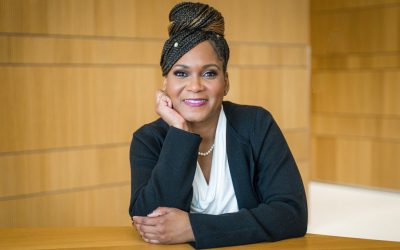An architect shares her designs for a sustainable planet
By Derek Herscovici ’14

Like most architects, Jane Frederick ’82 often finds inspiration while traveling abroad. In this particular instance, she was gazing at clashing styles from pre-Roman Empire to modern skyscrapers while in Baku, Azerbaijan.
Frederick, however, was not traveling for inspiration. As the president of the American Institute of Architects (AIA), she is the American representative to the Union of International Architects’ annual congress. Frederick was elected in the summer of 2018 and is the public face of the organization, promoting important issues and new advancements to help architecture firms around the country.
“The president is the public face of the AIA, but we’re also responsible for strategic planning and visioning,” said Frederick from her office in Beaufort, S.C. “Being out in the public, talking about what our goals are, what we’re doing and being an outward voice of the profession.”
Frederick says a major goal of her presidency is to increase the AIA’s efforts related to climate action, pointing to research stating nearly 40 percent of all generated energy generated is used on building operations like lighting, air conditioning and power, besides the “embodied carbon” pollution created from manufacturing materials like concrete and steel.
The daughter of an aerospace engineer and an interior decorator, Frederick was drawn to architecture by the impact it has on people and places.
“I think most architects really want to make a difference; they’re creating places for people to connect to the land, to enjoy the environment. Architects go into architecture because they want to make a difference.”
Frederick was on Auburn’s first women’s track team in 1978, but really found her ‘tribe’ among the architecture students, who were then and still are a very close-knit group of friends. It was in the architecture studio that she met her husband, Michael Frederick ’82, and though there were few women in the program at the time — and zero women professors — they formed a tight-knit group that still keeps in touch.
“We had to create our own fun when you’re out in the middle of nowhere, especially in the late 70s, early 80s, so we always had a lot of ‘dress-up parties,’ costume parties, that were a lot of fun; they were pretty elaborate.”
After Auburn, Frederick was living in Alexandria, Va., freelancing projects and raising children when the young family took a fortuitous vacation to Beaufort, South Carolina. Her and Michael loved the place so much, they returned, permanently, three months later and opened their firm Frederick + Frederick Architects in 1989.
Exactly 31 years later, the firm has hit its stride in homebuilding and restoration. Adapting to hurricanes and floodplains in South Carolina’s second-oldest city pushed Frederick to implement “Southern vernacular traditions” for sustainable, cost-effective design methods.
“How did our ancestors build before they had air conditioning? They were really paying attention to the environment. They did buildings one-room wide for cross ventilation, they raised them out of the flood plain, they had high ceilings for the heat to rise, they were oriented east-west to minimize the sun. If you use those principles in a contemporary way, you already start making your building more sustainable and using less energy than by forcing it to be air conditioned all the time.”
Adapting to new technology has helped Frederick come closer to “net-zero,” meaning the building produces all its own energy on-site. All of their homes’ light fixtures are LED, many use solar panels to offset power costs and instead of using a traditional generator, they use Tesla car batteries to store energy. The firm has also incorporated virtual reality headsets into their designs and client presentations.
Frederick will continue working at her firm while serving as AIA President, but the two roles are not mutually exclusive. As a private architect, she understands the trepidation of straying from tried-and-true methods and models, but as president, she wants to energize architects about new sustainability initiatives through the AIA’s research arm.
One of the biggest initiatives Frederick is undertaking is the “2030 Challenge,” which aims for all new buildings created by AIA architects to be “net-zero” by the year 2030. The initiative began in 2006, but since then, only 256 firms — roughly 1 percent of AIA constituents — are participating. Frederick wants to change that.
“We’re not going to get there if only 1 percent of the firms are participating; my goal is to double that in 2020. Hopefully we’ll do more than double, but if we can get that number of reporting firms doubled in 2020, we’re going to start doing a lot better.”
Though she never anticipated one day becoming president of the America Institute of Architects, Frederick is excited to be a part of real-world positive change moving forward.
“Architects have a vision that they want to see created; it’s more of an applied art than a fine art, I guess.”
Auburn Alum and NBC Entertainment Correspondent, Chloe Melas, is Making News
A meeting at Auburn’s student-run television station launched Chloe Melas’ career as an entertainment news correspondent for VH1, CNN and NBC news.
The Teacher’s Coach
She wanted to be a physical therapist, but now Joy Gaston Gayles ’98 helps support and inspire a new generation of professors.
Alumna Furnishes Homes for Homeless
A former nurse helps Michigan’s homeless create a new beginning, one piece of furniture at a time.
Auburn Alum and NBC Entertainment Correspondent, Chloe Melas, is Making News
A meeting at Auburn’s student-run television station launched Chloe Melas’ career as an entertainment news correspondent for VH1, CNN and NBC news.
The Teacher’s Coach
She wanted to be a physical therapist, but now Joy Gaston Gayles ’98 helps support and inspire a new generation of professors.
Alumna Furnishes Homes for Homeless
A former nurse helps Michigan’s homeless create a new beginning, one piece of furniture at a time.




